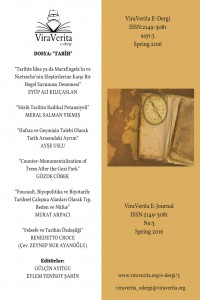Öz
Bu çalışma, Gezi Parkı olaylarından sonra AKP (Adalet ve Kalkınma Partisi) hükümetinin söyleminde artan ağaç vurgusunu ve önemini analiz ederek politika ve estetik arasındaki ilişkiyi ortaya çıkarmayı amaçlamaktadır. Çalışmanın teorik çerçevesi için Jacques Ranciere'in "duyusalın dağılımı" teorisi ile Marc Redfield'in "hayal-i ulus" (imagi-nation) kavramından ve söylem analizi için 2013'teki Gezi Parkı olayları sırasında eylemcilerle yaptığım mülakatlarla hükümetin olaylar üzerine yaptığı açıklamalardan faydalandım. Bu teorik çerçeve ve söylem analizi ışığında, Gezi Parkı olaylarının nasıl politik ve sosyal olduğu kadar estetik bir hareket olduğunu ve bu estetik hareketin nasıl ağacı özel bir anıt türüne, hayal-i ulusu mümkün kılan anıtları zorlayan ve evirten bir "karşı anıt" haline getirdiğini tartışmaktayım
Anahtar Kelimeler
Estetik politika hayal-i ulus duyusalın dağılımı karşı-anıt Gezi Parkı olayları
Kaynakça
- Bianet. (06.07.2013). “Vali Mutlu: Gezi Parkı’nda Gösteriye İzin Vermeyeceğiz.” http://bianet.org/bianet/toplum/148289-gezi-parki-nda-gosteriye-izin-vermeyecegiz
- Bugün. (08.07.2013). “Vali Mutlu’dan flaş Gezi Parkı Açıklaması.” http://www.bugun.com.tr/gundem/vali-mutludan-flas-gezi-parki-aciklamasi-haberi/711062
- Cazeaux, C. (2000). “Introduction” in The Continental Aesthetics Reader, ed. Clive Cazeaux. Routledge.
- Cöbek, Gözde. (2013). Gezi Parkı’nın Örgütsüz Kesiminin Sesi. Parrhesia E-Dergi 2(4), 25-27.
- Crownshaw, Richard. (2008). The German Countermonument: Conceptual Indeterminacies and the Retheorisation of the Arts of Vicarious Memory. Forum Mod Land Stud 44(2): 212- 227.
- Ete, Hatem & Coşkun Taştan. (2014). The Gezi Park Protests: A Political, Sociological and Discursive Analysis. Istanbul: SETA Yayınları. 2014.
- Hollier, Denis. (1993). “Introduction: Bloody Sundays” in Against Architecture: The Writings of Georges Bataille, trans. Betsy Wing. The MIT Press.
- Hürriyet. (12.06.2013). “Başbakan: Bu Tayyip Erdoğan değişmez.” http://www.hurriyet.com.tr/gundem/23479966.asp
- Lerner, Adam J. (1993). “The Nineteenth-Century Monument and the Embodiment of National Time” in Reimagining the Nation, eds. Marjorie Ringrose, Adam J. Lerner. Open University Press.
- Mitchell, Renae L. (2015). A Trans-Atlantic Vandal: Omeros and the Ekyphrastic Countermonument. Callaloo 38(1): 150-166.
- Ranciere, Jacques. (2003). “Politics and Aesthetics: An Interview.” Angelaki: Journal of the Theoretical Humanities, vol 8. No. 2.
- Ranciere, Jacques. (2004). The Politics of Aesthetics: The Distribution of the Sensible. Continuum.
- Redfield, Marc. (2003). The Politics of Aesthetics: Nationalism, Gender, Romanticism. Stanford University Press.
- Sabah. (01.06.2013). “Başbakan’dan Gezi Parkı Açıklaması.” http://www.sabah.com.tr/gundem/2013/06/01/basbakan-erdogan-konusuyor
- Sennett, Richard. (1994). Flesh and Stone: The Body and the City in Western Civilization. W. W. Norton and Company.
- Stevens, Q, K. Franck & R. Fazakerley. (2012). Counter-monuments: the anti-monumental and the dialogic. The Journal of Architecture, 17(6): 951-972.
- Strakosch, Elizabeth. (2010). Counter-Monuments and Nation-Building in Australia. Peace Review: A Journal of Social Justice 22(3): 268-275.
- Stubblefield, Thomas. (2011). Do Disappearing Monuments Simply Disappear? The CounterMonument in Revision. Future Anterior Vol. VIII, No. 2.
- Yaman, Zeynep Yasa. (2011). “Siyasi/Estetik Gösterge” Olarak Kamusal Alanda Anıt ve Heykel. METU JFA 28(1): 51-80.
- Young, James. (1992). The Counter-Monument against Itself in Germany Today. The University of Chicago Press: Critical Inquiry, 18(2): 267-296
Öz
This study aims to explore the relationship between politics and aesthetics by analyzing the growing emphasis on and importance of the concept of tree in the AKP (the Justice and Development Party) government's discourse after the Gezi Park protests. Following both Jacques Ranciere's theory of “the distribution of the sensory”, and Marc Redfield's concept of “imagi-nation” for my theoretical framework and making use of the narratives of the protesters that I interviewed with during the Gezi Park protests in 2013 and the narratives of the government about these events for my discourse analysis, I argue how the Gezi events are an aesthetic movement as well as a political and social one, and how this aesthetic movement leads trees to become a special kind of monument, "counter-monument" which challenges and inverts the monuments that allow us for imagi-nation.
Anahtar Kelimeler
Aesthetics politics imagi-nation the distribution of the sensory counter-monument the Gezi Park protests.
Kaynakça
- Bianet. (06.07.2013). “Vali Mutlu: Gezi Parkı’nda Gösteriye İzin Vermeyeceğiz.” http://bianet.org/bianet/toplum/148289-gezi-parki-nda-gosteriye-izin-vermeyecegiz
- Bugün. (08.07.2013). “Vali Mutlu’dan flaş Gezi Parkı Açıklaması.” http://www.bugun.com.tr/gundem/vali-mutludan-flas-gezi-parki-aciklamasi-haberi/711062
- Cazeaux, C. (2000). “Introduction” in The Continental Aesthetics Reader, ed. Clive Cazeaux. Routledge.
- Cöbek, Gözde. (2013). Gezi Parkı’nın Örgütsüz Kesiminin Sesi. Parrhesia E-Dergi 2(4), 25-27.
- Crownshaw, Richard. (2008). The German Countermonument: Conceptual Indeterminacies and the Retheorisation of the Arts of Vicarious Memory. Forum Mod Land Stud 44(2): 212- 227.
- Ete, Hatem & Coşkun Taştan. (2014). The Gezi Park Protests: A Political, Sociological and Discursive Analysis. Istanbul: SETA Yayınları. 2014.
- Hollier, Denis. (1993). “Introduction: Bloody Sundays” in Against Architecture: The Writings of Georges Bataille, trans. Betsy Wing. The MIT Press.
- Hürriyet. (12.06.2013). “Başbakan: Bu Tayyip Erdoğan değişmez.” http://www.hurriyet.com.tr/gundem/23479966.asp
- Lerner, Adam J. (1993). “The Nineteenth-Century Monument and the Embodiment of National Time” in Reimagining the Nation, eds. Marjorie Ringrose, Adam J. Lerner. Open University Press.
- Mitchell, Renae L. (2015). A Trans-Atlantic Vandal: Omeros and the Ekyphrastic Countermonument. Callaloo 38(1): 150-166.
- Ranciere, Jacques. (2003). “Politics and Aesthetics: An Interview.” Angelaki: Journal of the Theoretical Humanities, vol 8. No. 2.
- Ranciere, Jacques. (2004). The Politics of Aesthetics: The Distribution of the Sensible. Continuum.
- Redfield, Marc. (2003). The Politics of Aesthetics: Nationalism, Gender, Romanticism. Stanford University Press.
- Sabah. (01.06.2013). “Başbakan’dan Gezi Parkı Açıklaması.” http://www.sabah.com.tr/gundem/2013/06/01/basbakan-erdogan-konusuyor
- Sennett, Richard. (1994). Flesh and Stone: The Body and the City in Western Civilization. W. W. Norton and Company.
- Stevens, Q, K. Franck & R. Fazakerley. (2012). Counter-monuments: the anti-monumental and the dialogic. The Journal of Architecture, 17(6): 951-972.
- Strakosch, Elizabeth. (2010). Counter-Monuments and Nation-Building in Australia. Peace Review: A Journal of Social Justice 22(3): 268-275.
- Stubblefield, Thomas. (2011). Do Disappearing Monuments Simply Disappear? The CounterMonument in Revision. Future Anterior Vol. VIII, No. 2.
- Yaman, Zeynep Yasa. (2011). “Siyasi/Estetik Gösterge” Olarak Kamusal Alanda Anıt ve Heykel. METU JFA 28(1): 51-80.
- Young, James. (1992). The Counter-Monument against Itself in Germany Today. The University of Chicago Press: Critical Inquiry, 18(2): 267-296
Ayrıntılar
| Diğer ID | JA35NH47AU |
|---|---|
| Bölüm | Makaleler |
| Yazarlar | |
| Yayımlanma Tarihi | 13 Temmuz 2016 |
| Gönderilme Tarihi | 13 Temmuz 2016 |
| Yayımlandığı Sayı | Yıl 2016 Sayı: 3 |


